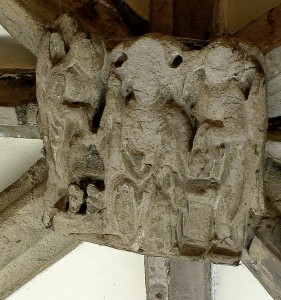December 6th is St Nicholas Day. Last year we featured one of the stained glass windows in the West Kirk depicting St Nicholas and outlined what is known – and not known – about him. This year the photograph is of the stone boss over the crossing in St Mary’s Chapel. It represents the reverse of the City Seal made in 1430 and features St Nicholas, the patron saint of Aberdeen. The boss over the north aisle in St Mary’s Chapel features the front of this City Seal. It is the earliest known representation of the seal, apart from the actual seal itself, however the one in the north aisle is so badly eroded that no features can be distinguished today. Both these bosses are made of freestone and date from the mid-1400s when the chapel was built.

The particular story about St Nicholas depicted on the seal is that of raising three boys to life. There are variants on the story, but the essence is that the three boys were captured, killed and pickled. When Bishop Nicholas of Myra (St Nicholas) heard of this he had the murderer killed and brought the boys back to life again. Because the boss is worn, high up and the lighting is awkward, it is difficult to get a clear photograph of this particular boss, although some of the features do seem to be clearer than seeing it with the naked eye. The accompanying photograph is of the boss and shows St Nicholas, in the centre, dressed as a Latin bishop including a mitre on his head (rather indistinct at the top) and with his right hand either holding a crozier or raised in benediction. The boys, only two visible, are at the bottom left, surrounded by a structure, presumably the pickling vat, as they are restored to life. There are two other figures, one on either side of St Nicholas, which appear to have wings, so they are probably angels lending their assistance to the miracle. This miracle is one of those which Benjamin Britten included in his cantata ‘St Nicholas’ which he composed in 1948.